#web development lifecycle
Explore tagged Tumblr posts
Text

Low-code solutions may nevertheless require some coding to implement complex logic or special features. However, the overall process is streamlined, web development company bring software ideas to life much faster. It makes low-code solutions a game-changer, promoting innovation and agility in a world demanding rapid adaptation.
#web development lifecycle#low code app development#web development trends#custom web development#web development services
0 notes
Text
Get full insights of web application development lifecycle & iProgrammer Web Application Development Services can help to develop best Web Apps for your Business.
#web app development#web application development#web application development lifecycle#web application development process#Web application development services
0 notes
Text
okee my performance eval is in my portal so i wanted to make a little thing i can reference when i'm Going Through It...i'm not putting my worth in my job, trust me, but some of these compliments are just...they're a lot more thoughtful than "she works hard" lol
here's some copy/pasted quotes in no particular order, starting with some project-specific stuff:
Her adaptability, technical initiative and rapid progress were critical to delivering a fully functioning, design system-based theme that will be used campus-wide. Her efforts were essential to the success of this project.
Not only did [NAME] help deliver the core WordPress theme with no prior experience in PHP, but she simultaneously designed and help develop a child theme specifically for the [REDACTED] site. She was able to manage this while the content for the [REDACTED] site was still in flux, requiring her to adapt quickly to evolving design, front-end and backend needs. Despite these shifting requirements and tight deadlines, [NAME] consistently delivered high-quality, pixel-perfect design comps, implemented front-end CSS and executed backend integration when needed with impressive speed and efficiency.
[NAME] has demonstrated exceptional performance and leadership in her role and is the primary contributor to the design system. Among a team of five contributors, she has resolved more than 65% of all GitHub tickets, including both bugs and feature requests. Her involvement spans the full product lifecycle--contributing to ideation, design, front-end development with pixel precision, and CMS integration.
and here's some general comments:
[NAME] has been a critical asset to the success of the team by leading the design and being a lead developer for the [REDACTED] UX Web Design System and related projects. She has maintained the design and front-end development of system components, maintained the Figma library and provided consistent support to campus teams through training, documentation and office hours. Despite no prior experience in PHP, she quickly learned and contributed significantly to building and launching the WordPress theme and a custom [REDACTED] child theme. Her strong work ethic, adaptability and attention to detail ensured high-quality, accessible and brand-compliant work under tight deadlines. [NAME]'s impact has been campus-wide and her contributions have been instrumental in advancing design system adoption and execution.
[NAME] demonstrates a strong sense of accountability by taking full ownership of her work and consistently delivering high-quality results. She follows through on commitments, meets deadlines even under tight timelines and holds herself to a high standard of accuracy and consistency--particularly in design, accessibility, usability and brand compliance. Her reliability has made her a go-to team member on high-impact projects, and her attention to detail ensures that nothing falls through the cracks.
[NAME] consistently demonstrates initiative by proactively identifying needs, taking ownership of complex tasks and delivering high-quality work with minimal supervision. She exceeded expectations by independently learning PHP to contribute to backend development and took the lead on critical design system components without being asked. Her ability to self-direct, anticipate challenges and follow through has made her a reliable and trusted contributor across every phase of a project.
and the overall comment/rating:
[NAME] has consistently exceeded expectations in her role, demonstrating exceptional initiative and accountability. As the lead developer to the [REDACTED] UX Web Design System, she has driven the design, development and support of system components with precision and care, resolving more than 65% of all GitHub tickets. Her proactive approach, technical adaptability and attention to accessibility and usability have made her indispensable to both the internal team and the broader campus community. She takes full ownership of her work, delivers high-quality results with minimal supervision and regularly supports others. Her impact is visible across every facet of the project lifecycle-from frontend and backend development to design system adoption and campus-wide implementation.
there were plenty of other positive comments but these were some that really stood out to me. sometimes it's nice to be reminded that i'm smort :^)
3 notes
·
View notes
Text
What is Argo CD? And When Was Argo CD Established?

What Is Argo CD?
Argo CD is declarative Kubernetes GitOps continuous delivery.
In DevOps, ArgoCD is a Continuous Delivery (CD) technology that has become well-liked for delivering applications to Kubernetes. It is based on the GitOps deployment methodology.
When was Argo CD Established?
Argo CD was created at Intuit and made publicly available following Applatix’s 2018 acquisition by Intuit. The founding developers of Applatix, Hong Wang, Jesse Suen, and Alexander Matyushentsev, made the Argo project open-source in 2017.
Why Argo CD?
Declarative and version-controlled application definitions, configurations, and environments are ideal. Automated, auditable, and easily comprehensible application deployment and lifecycle management are essential.
Getting Started
Quick Start
kubectl create namespace argocd kubectl apply -n argocd -f https://raw.githubusercontent.com/argoproj/argo-cd/stable/manifests/install.yaml
For some features, more user-friendly documentation is offered. Refer to the upgrade guide if you want to upgrade your Argo CD. Those interested in creating third-party connectors can access developer-oriented resources.
How it works
Argo CD defines the intended application state by employing Git repositories as the source of truth, in accordance with the GitOps pattern. There are various approaches to specify Kubernetes manifests:
Applications for Customization
Helm charts
JSONNET files
Simple YAML/JSON manifest directory
Any custom configuration management tool that is set up as a plugin
The deployment of the intended application states in the designated target settings is automated by Argo CD. Deployments of applications can monitor changes to branches, tags, or pinned to a particular manifest version at a Git commit.
Architecture
The implementation of Argo CD is a Kubernetes controller that continually observes active apps and contrasts their present, live state with the target state (as defined in the Git repository). Out Of Sync is the term used to describe a deployed application whose live state differs from the target state. In addition to reporting and visualizing the differences, Argo CD offers the ability to manually or automatically sync the current state back to the intended goal state. The designated target environments can automatically apply and reflect any changes made to the intended target state in the Git repository.
Components
API Server
The Web UI, CLI, and CI/CD systems use the API, which is exposed by the gRPC/REST server. Its duties include the following:
Status reporting and application management
Launching application functions (such as rollback, sync, and user-defined actions)
Cluster credential management and repository (k8s secrets)
RBAC enforcement
Authentication, and auth delegation to outside identity providers
Git webhook event listener/forwarder
Repository Server
An internal service called the repository server keeps a local cache of the Git repository containing the application manifests. When given the following inputs, it is in charge of creating and returning the Kubernetes manifests:
URL of the repository
Revision (tag, branch, commit)
Path of the application
Template-specific configurations: helm values.yaml, parameters
A Kubernetes controller known as the application controller keeps an eye on all active apps and contrasts their actual, live state with the intended target state as defined in the repository. When it identifies an Out Of Sync application state, it may take remedial action. It is in charge of calling any user-specified hooks for lifecycle events (Sync, PostSync, and PreSync).
Features
Applications are automatically deployed to designated target environments.
Multiple configuration management/templating tools (Kustomize, Helm, Jsonnet, and plain-YAML) are supported.
Capacity to oversee and implement across several clusters
Integration of SSO (OIDC, OAuth2, LDAP, SAML 2.0, Microsoft, LinkedIn, GitHub, GitLab)
RBAC and multi-tenancy authorization policies
Rollback/Roll-anywhere to any Git repository-committed application configuration
Analysis of the application resources’ health state
Automated visualization and detection of configuration drift
Applications can be synced manually or automatically to their desired state.
Web user interface that shows program activity in real time
CLI for CI integration and automation
Integration of webhooks (GitHub, BitBucket, GitLab)
Tokens of access for automation
Hooks for PreSync, Sync, and PostSync to facilitate intricate application rollouts (such as canary and blue/green upgrades)
Application event and API call audit trails
Prometheus measurements
To override helm parameters in Git, use parameter overrides.
Read more on Govindhtech.com
#ArgoCD#CD#GitOps#API#Kubernetes#Git#Argoproject#News#Technews#Technology#Technologynews#Technologytrends#govindhtech
2 notes
·
View notes
Text
Full Stack Testing vs. Full Stack Development: What’s the Difference?

In today’s fast-evolving tech world, buzzwords like Full Stack Development and Full Stack Testing have gained immense popularity. Both roles are vital in the software lifecycle, but they serve very different purposes. Whether you’re a beginner exploring your career options or a professional looking to expand your skills, understanding the differences between Full Stack Testing and Full Stack Development is crucial. Let’s dive into what makes these two roles unique!
What Is Full Stack Development?
Full Stack Development refers to the ability to build an entire software application – from the user interface to the backend logic – using a wide range of tools and technologies. A Full Stack Developer is proficient in both front-end (user-facing) and back-end (server-side) development.
Key Responsibilities of a Full Stack Developer:
Front-End Development: Building the user interface using tools like HTML, CSS, JavaScript, React, or Angular.
Back-End Development: Creating server-side logic using languages like Node.js, Python, Java, or PHP.
Database Management: Handling databases such as MySQL, MongoDB, or PostgreSQL.
API Integration: Connecting applications through RESTful or GraphQL APIs.
Version Control: Using tools like Git for collaborative development.
Skills Required for Full Stack Development:
Proficiency in programming languages (JavaScript, Python, Java, etc.)
Knowledge of web frameworks (React, Django, etc.)
Experience with databases and cloud platforms
Understanding of DevOps tools
In short, a Full Stack Developer handles everything from designing the UI to writing server-side code, ensuring the software runs smoothly.
What Is Full Stack Testing?
Full Stack Testing is all about ensuring quality at every stage of the software development lifecycle. A Full Stack Tester is responsible for testing applications across multiple layers – from front-end UI testing to back-end database validation – ensuring a seamless user experience. They blend manual and automation testing skills to detect issues early and prevent software failures.
Key Responsibilities of a Full Stack Tester:
UI Testing: Ensuring the application looks and behaves correctly on the front end.
API Testing: Validating data flow and communication between services.
Database Testing: Verifying data integrity and backend operations.
Performance Testing: Ensuring the application performs well under load using tools like JMeter.
Automation Testing: Automating repetitive tests with tools like Selenium or Cypress.
Security Testing: Identifying vulnerabilities to prevent cyber-attacks.
Skills Required for Full Stack Testing:
Knowledge of testing tools like Selenium, Postman, JMeter, or TOSCA
Proficiency in both manual and automation testing
Understanding of test frameworks like TestNG or Cucumber
Familiarity with Agile and DevOps practices
Basic knowledge of programming for writing test scripts
A Full Stack Tester plays a critical role in identifying bugs early in the development process and ensuring the software functions flawlessly.
Which Career Path Should You Choose?
The choice between Full Stack Development and Full Stack Testing depends on your interests and strengths:
Choose Full Stack Development if you love coding, creating interfaces, and building software solutions from scratch. This role is ideal for those who enjoy developing creative products and working with both front-end and back-end technologies.
Choose Full Stack Testing if you have a keen eye for detail and enjoy problem-solving by finding bugs and ensuring software quality. If you love automation, performance testing, and working with multiple testing tools, Full Stack Testing is the right path.
Why Both Roles Are Essential :
Both Full Stack Developers and Full Stack Testers are integral to software development. While developers focus on creating functional features, testers ensure that everything runs smoothly and meets user expectations. In an Agile or DevOps environment, these roles often overlap, with testers and developers working closely to deliver high-quality software in shorter cycles.
Final Thoughts :
Whether you opt for Full Stack Testing or Full Stack Development, both fields offer exciting opportunities with tremendous growth potential. With software becoming increasingly complex, the demand for skilled developers and testers is higher than ever.
At TestoMeter Pvt. Ltd., we provide comprehensive training in both Full Stack Development and Full Stack Testing to help you build a future-proof career. Whether you want to build software or ensure its quality, we’ve got the perfect course for you.
Ready to take the next step? Explore our Full Stack courses today and start your journey toward a successful IT career!
This blog not only provides a crisp comparison but also encourages potential students to explore both career paths with TestoMeter.
For more Details :
Interested in kick-starting your Software Developer/Software Tester career? Contact us today or Visit our website for course details, success stories, and more!
🌐visit - https://www.testometer.co.in/
2 notes
·
View notes
Text
Simplifying Website Design and Development: Your Ultimate Guide
Simplifying Website Design and Development: Your Ultimate Guide
In today's digital age, having a strong online presence is essential for businesses of all sizes. A well-designed and developed website not only enhances your brand image but also serves as a powerful marketing tool to attract and engage customers. In this comprehensive guide, we'll explore everything you need to know about website design and development, including services, companies, and agencies in the USA and Canada.
Understanding Website Design and Development
Website design and development encompass the process of creating and building a website from scratch or redesigning an existing one. It involves various elements such as layout design, user interface (UI) and user experience (UX) design, coding, content creation, and optimization for search engines.
Website Design and Development Services
Professional website design and development services cater to the diverse needs of businesses seeking to establish or enhance their online presence. These services typically include:
Custom Website Design: Tailored design solutions to reflect your brand identity and meet specific business objectives.
Responsive Web Development: Building websites that adapt seamlessly to different devices and screen sizes for optimal user experience.
E-commerce Development: Creating online stores with secure payment gateways, product catalogs, and shopping cart functionality.
Content Management Systems (CMS): Integration of user-friendly CMS platforms like WordPress, Joomla, or Drupal for easy website management.
Search Engine Optimization (SEO): Implementing strategies to improve website visibility and rankings on search engine results pages (SERPs).
Website Maintenance and Support: Ongoing support, updates, and maintenance services to ensure website performance and security.
Website Design and Development Companies and Agencies
In the USA and Canada, numerous companies and agencies specialize in website design and development. These firms offer expertise in creating high-quality websites tailored to clients' unique needs and preferences. Some key characteristics to look for in a reputable website design and development company or agency include:
Experience and Expertise: Choose a company with a proven track record of delivering successful projects across various industries.
Portfolio: Review their portfolio of past work to gauge the quality and diversity of their designs and developments.
Client Reviews and Testimonials: Read reviews and testimonials from previous clients to assess their satisfaction and experiences.
Communication and Collaboration: Look for a company that emphasizes clear communication and collaboration throughout the project lifecycle.
Affordability and Value: Consider companies that offer competitive pricing without compromising on quality and value-added services.
Website Design and Development Companies in the USA and Canada
In the USA, reputable website design and development companies include:
ABC Web Solutions: A leading web development firm specializing in custom website design, e-commerce solutions, and digital marketing services.
XYZ Creative Agency: Known for innovative web design, responsive development, and SEO optimization strategies tailored to clients' specific needs.
123 Digital Studio: Providing comprehensive website design and development services, including UI/UX design, CMS integration, and ongoing support.
In Canada, notable website design and development companies include:
Maple Leaf Web Design: Offering professional website design, e-commerce development, and SEO services for businesses across Canada.
Great White North Digital: Specializing in responsive web design, custom development, and online marketing solutions to help Canadian businesses thrive online.
True North Web Solutions: A full-service web agency providing creative design, robust development, and strategic digital solutions tailored to clients' goals.
Conclusion
Investing in professional website design and development is crucial for businesses looking to establish a strong online presence and attract customers. By understanding the services offered and choosing reputable companies or agencies, you can create a visually appealing, functional, and user-friendly website that drives business growth and success.
Whether you're based in the USA or Canada, there are numerous options available to help you achieve your website design and development goals. Take the time to research, compare, and select the right partner to bring your vision to life and propel your business forward in the digital landscape.
#website#webdesign#webdevelopment#website development#web developing company#web design#web developers#website optimization#website developer near me#website design
3 notes
·
View notes
Text
Revolutionizing Web Testing: A Deep Dive into Selenium's Automation Dynamics
In the rapidly evolving digital arena, the assurance of flawless functionality, optimal performance, and responsiveness of web applications is a non-negotiable aspect of software development. Selenium, an open-source automation framework, emerges as a formidable force in achieving these objectives. In this comprehensive exploration, we will delve into the intricacies of Selenium, unraveling its role in automation, dissecting the components comprising its toolkit, and understanding its profound impact on modern web testing practices.

1. Decoding Selenium: A Core Element of Automation Mastery
At its essence, Selenium represents a suite of tools meticulously crafted to automate web browsers. This automation plays a pivotal role in the testing domain, where the simulation of user interactions is imperative for validating the functionality and performance of web applications. Beyond testing, Selenium significantly contributes to the efficiency and reliability of the software development lifecycle.
2. The Toolbox Essentials: Navigating Selenium's Arsenal
Selenium's toolkit comprises three indispensable components, each serving a distinct purpose in the automation journey.
Selenium IDE:
Selenium IDE, a browser extension, simplifies the recording, editing, and debugging of tests. With a user-friendly interface, testers can effortlessly create and modify test cases.
Selenium WebDriver:
The crux of Selenium lies in WebDriver, a tool facilitating interaction with web browsers through diverse programming languages. This component is instrumental in crafting dynamic and programmable test scripts.
Selenium Grid:
Selenium Grid acts as a scalable solution enabling parallel test execution across multiple machines and browsers. This feature expedites the testing process by distributing test cases effectively.
3. Language Flexibility: Adaptable Automation at its Finest
A standout feature of Selenium is its support for multiple programming languages, including Java, Python, C#, and Ruby. This flexibility empowers testers and developers to harness Selenium's capabilities within their preferred programming language, fostering seamless integration into existing workflows.
4. Cross-Browser Compatibility: Ensuring Uniformity in Diversity
Selenium's prowess shines in its ability to conduct cross-browser testing with efficiency. In the era where web applications must perform consistently across various browsers, Selenium ensures uniformity in testing scenarios across Chrome, Firefox, Safari, and more. This cross-browser compatibility is paramount for delivering a consistent user experience.
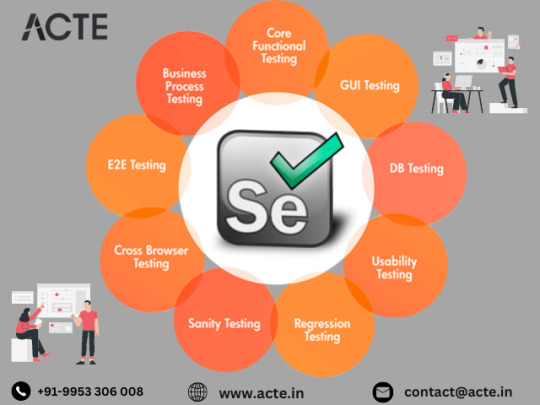
5. Dynamic Web Element Handling: Mastering Change
In the dynamic landscape of web development, the adept handling of dynamic web elements stands as a critical testing aspect. Selenium excels in providing robust mechanisms to identify and interact with elements that undergo changes based on user interactions. This adaptability guarantees accurate testing even in scenarios where web elements are subject to modification.
6. Integration with Testing Frameworks: Orchestrating Efficient Test Management
Selenium seamlessly integrates with renowned testing frameworks like JUnit and TestNG. This integration enhances the efficiency of test management, execution, and reporting. Testing frameworks offer a structured approach to test development, simplifying the management, execution, and analysis of test results.
7. Parallel Test Execution: Turbocharging Processes
Selenium Grid emerges as a powerhouse solution for accelerating test execution. By facilitating parallel execution of tests across multiple machines and browsers, Selenium Grid substantially reduces test execution time. This parallelization proves invaluable, especially when dealing with extensive test suites that require swift execution.
8. Community Support and Continuous Advancement: Sustaining an Ecosystem
Selenium thrives on the strength of its community. With a dynamic community of developers, testers, and automation enthusiasts, Selenium undergoes continuous refinement and enhancement. Regular updates, bug fixes, and the introduction of new features ensure that Selenium aligns seamlessly with the ever-evolving web technology landscape.
Conclusion: Selenium as the Cornerstone of Automated Precision
In conclusion, Selenium stands tall as a cornerstone in the realm of automation, particularly in web testing. Its adaptability, cross-browser testing capabilities, integration with testing frameworks, and support for parallel test execution position it as an indispensable tool for ensuring the quality and reliability of web applications.
Whether you're a seasoned tester or a developer navigating the intricacies of web testing, Selenium equips you to streamline your testing processes. Its impact resonates in the delivery of high-quality software, contributing to the seamless user experience expected in the dynamic digital landscape.
As we delve into the myriad facets of Selenium, we uncover its transformative power in reshaping testing practices and fortifying the foundations of robust and reliable web applications. Embrace the influence of Selenium, and let it be your guiding force in the captivating journey of web automation.
4 notes
·
View notes
Text
Master the Recipe for Success: DevOps Training to Fuel Innovation and Growth
In today's technology-driven world, businesses across industries are constantly striving to enhance their operations and stay ahead of the competition. Successful companies understand that innovation and growth go hand in hand, and one key ingredient in this recipe for success is DevOps training. By investing in DevOps education and information technology (IT), organizations can equip their teams with the necessary skills and knowledge to streamline development processes, promote collaboration, and drive efficiency. This article explores the significance of DevOps training and how it can fuel innovation and growth within an organization.

The Advantages of DevOps Training
DevOps training offers numerous benefits to organizations seeking to optimize their development lifecycle and foster a culture of innovation. Here are some advantages associated with investing in DevOps education:
Enhanced Collaboration: DevOps training promotes a collaborative mindset by breaking down silos between development and operations teams. Through cross-functional training, individuals gain a deeper understanding of each other's roles, fostering communication and cooperation.
Streamlined Development Processes: With a strong DevOps foundation, businesses can streamline their development processes by implementing automation, continuous integration, and continuous delivery (CI/CD) practices. These streamlined processes reduce bottlenecks, minimize errors, and accelerate time-to-market.
Improved Efficiency and Productivity: By equipping employees with the necessary skills to effectively utilize DevOps tools and techniques, organizations can dramatically enhance efficiency and productivity. Training empowers team members to leverage automation tools, optimize workflows, and reduce manual effort.
Better Quality and Reliability: Through DevOps education, individuals gain expertise in implementing robust testing practices and quality assurance techniques. This results in improved software reliability, minimal downtime, and enhanced customer satisfaction.
Exploring DevOps Training Options
When considering DevOps training, organizations have a range of options to choose from. These options cater to diverse learning preferences and can be tailored to meet specific business needs. Here are some popular DevOps training choices:
1. Instructor-Led Training
Instructor-led training programs offer a structured approach to learning, combining theoretical concepts with hands-on exercises. Students benefit from real-time interaction with experienced instructors and fellow learners, fostering a deeper understanding of DevOps principles and best practices.
2. Online Courses
Online courses provide flexibility and convenience for individuals seeking to acquire DevOps skills at their own pace. These courses often consist of pre-recorded videos, interactive quizzes, and comprehensive learning materials. Students can access the content anytime, anywhere, making it ideal for busy professionals.
3. Certifications
Obtaining a recognized DevOps certification can be a valuable asset for career advancement and professional growth. Certifications validate an individual's expertise in DevOps methodologies and tools, instilling confidence in employers and clients alike. Several reputable organizations offer DevOps certifications, such as the DevOps Institute and Amazon Web Services.

The Role of IT in DevOps Training
Information technology plays a pivotal role in enabling successful DevOps training initiatives. IT teams act as facilitators, providing the necessary infrastructure, tools, and resources to support training efforts. Here are essential aspects of IT's involvement:
Provision of Training Environments: IT departments ensure the availability of training environments, such as virtual machines or cloud-based labs, where learners can practice deploying software, configuring systems, and working with various DevOps tools.
Management of Training Platforms: IT teams oversee and maintain the learning platforms used for delivering DevOps training. This involves ensuring proper access control, monitoring system performance, and troubleshooting any technical issues that may arise.
Support for Tool Adoption: IT professionals assist in the adoption and integration of DevOps tools into existing systems. This includes providing guidance on tool selection, configuration, and customization to align with an organization's unique requirements.
Security and Compliance Considerations: IT personnel play a crucial role in ensuring that all training activities align with security policies and compliance regulations. They implement measures to protect sensitive data, secure communication channels, and maintain the integrity of training environments.
DevOps training serves as a catalyst for innovation and growth within organizations by fostering collaboration, streamlining development processes, improving efficiency, and promoting quality. By investing in ACTE institute DevOps training options, businesses can equip their teams with the knowledge and skills needed to adapt and thrive in an ever-evolving digital landscape. With the crucial support of information technology, organizations can maximize the potential of DevOps training and embark on a path towards sustained success.
9 notes
·
View notes
Text
Unveiling the Essential Role of Full Stack Developers in Modern Web Development
Introduction:
Within the dynamic realm of web development, full stack developers stand out as indispensable assets, offering a unique blend of expertise in both frontend and backend technologies. Their versatility enables them to navigate through various aspects of web application development, from crafting user interfaces to managing databases and server-side logic.

In this article, we'll delve into the essential role of full stack developers, shedding light on their pivotal contributions to streamlining development processes and fostering innovation within the industry.
1. Comprehensive Development Capabilities:
An integral aspect of full stack developers lies in their adeptness at overseeing end-to-end development projects. From initial concept to deployment, these professionals are proficient in every stage of the development lifecycle. They excel at designing intuitive user interfaces, implementing intricate frontend functionality, crafting robust backend logic, seamlessly integrating databases, and orchestrating smooth deployment of applications. This holistic approach ensures coherence and uniformity across the entirety of the project.
2. Proficient Problem Solvers:
Full stack developers possess a profound understanding of both frontend and backend technologies, equipping them with the skills to address issues at varying levels of the application stack. Their extensive skill set enables them to identify and resolve challenges efficiently, thereby minimizing downtime and ensuring the seamless operation of web applications. Whether it entails debugging frontend UI glitches or optimizing backend performance, full stack developers excel in devising effective solutions to intricate technical hurdles.
3. Collaborative Cross-Functional Engagement:
Effective collaboration is paramount in any development endeavor, and full stack developers are adept at fostering cross-functional teamwork. With their comprehensive grasp of frontend and backend technologies, they facilitate seamless communication and collaboration among designers, frontend developers, backend developers, and project managers. This cohesive teamwork ensures alignment on project objectives and facilitates smooth execution of tasks throughout the development journey.
4. Streamlined Development Processes:
The presence of a single developer proficient in both frontend and backend tasks results in a more streamlined and efficient development process. Full stack developers seamlessly transition between frontend and backend development, thereby mitigating communication gaps and reducing the need for handoffs between different team members. This streamlined approach translates into faster development cycles, rapid iterations, and ultimately, shortened time-to-market for web applications.
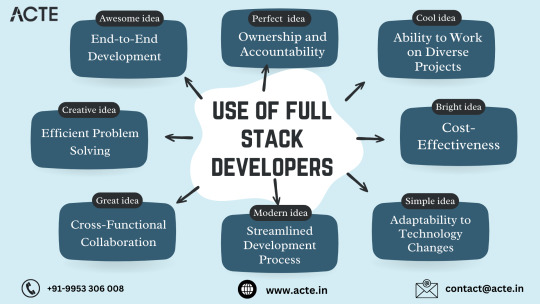
5. Adaptability to Technological Advancements:
In a landscape characterized by constant evolution, full stack developers are well-equipped to adapt to emerging trends and integrate new technologies into their projects. Their ability to stay abreast of the latest developments ensures they remain at the forefront of innovation in web development, thereby enabling them to deliver cutting-edge solutions tailored to meet the evolving needs of clients and users alike.
6. Cost-Efficiency:
Employing separate specialists for frontend and backend development can incur substantial costs for businesses. Conversely, engaging a full stack developer who can adeptly handle both roles offers a more cost-effective alternative. This approach not only reduces development expenditures but also minimizes overhead and administrative burdens associated with project management. Furthermore, having a singular point of contact for development tasks enhances communication and expedites decision-making processes.
7. Versatility in Project Execution:
Full stack developers possess the versatility to tackle a diverse array of projects, ranging from simple websites to complex web applications. This flexibility enables them to address varied challenges and contribute effectively to a wide spectrum of projects. Whether it involves crafting e-commerce platforms, content management systems, or social networking sites, full stack developers boast the expertise and adaptability to deliver bespoke solutions tailored to the unique requirements of each project.
8. Ownership and Commitment:
Often assuming ownership of the projects they undertake, full stack developers exhibit a heightened sense of accountability and dedication. This intrinsic ownership fosters a greater commitment to project success, as developers become personally invested in achieving favorable outcomes. By assuming responsibility for the entire development process, full stack developers ensure projects are delivered punctually, within budget constraints, and in adherence to the highest quality standards.
Conclusion:
In summary, full stack developers occupy a pivotal position in the realm of web development, leveraging their versatile skill sets and comprehensive understanding of frontend and backend technologies to drive innovation and excellence. By harnessing the unique capabilities of full stack developers, businesses can streamline development processes, stimulate innovation, and deliver unparalleled web experiences to their audience.
#full stack developer#education#information#full stack web development#front end development#frameworks#web development#backend#full stack developer course#technology
4 notes
·
View notes
Text
The Profound Benefits of Embracing Full Stack Development
Introduction: In the dynamic realm of software development, full stack developers have emerged as indispensable assets, equipped with the skills to navigate both front-end and back-end technologies seamlessly. This comprehensive exploration sheds light on the multifaceted advantages of embracing full stack development, unveiling the unique benefits and opportunities that accompany proficiency in both facets of the development stack.

Unlocking the Benefits of Full Stack Development:
Versatility and Adaptability: Full stack developers possess a diverse skill set, encompassing proficiency in both front-end and back-end technologies. This versatility enables them to fluidly transition between different aspects of development, adeptly adapting to project requirements and challenges.Mastery of client-side and server-side technologies empowers full stack developers to tackle a myriad of tasks, from crafting intuitive user interfaces to implementing complex business logic. This adaptability renders them invaluable assets to development teams, capable of contributing to various stages of the software development lifecycle with finesse.
Comprehensive Project Ownership: A defining advantage of full stack developers lies in their ability to assume end-to-end ownership of projects, from inception to deployment. With a comprehensive understanding of both front-end and back-end technologies, full stack developers can oversee all facets of development, ensuring seamless integration and coherence throughout the project lifecycle.This holistic perspective empowers full stack developers to make informed decisions at every juncture of development, from conceptualization and architecture to execution and optimization. By embracing responsibility for the entire project, full stack developers drive efficiency, consistency, and quality, culminating in successful project outcomes.
Expanded Employability and Career Prospects: Full stack developers are highly coveted by employers owing to their diverse skill set and capacity to work across multiple technologies. Proficiency in both front-end and back-end technologies opens the door to a plethora of career opportunities across various industries and sectors.Employers prize full stack developers for their adaptability, versatility, and ability to deliver end-to-end solutions that align with business objectives. Whether it entails developing web applications, mobile apps, or enterprise software, full stack developers are poised to excel in diverse roles and environments, making them sought-after candidates in the job market.
Efficient Collaboration and Communication: Full stack developers excel in cross-functional collaboration, proficiently communicating with designers, product managers, and fellow developers alike. Their grasp of both front-end and back-end technologies bridges the gap between different teams and departments, fostering smoother communication and collaboration.This collaborative prowess enables full stack developers to seamlessly integrate with cross-functional teams, ensuring that project requirements are comprehended, feedback is incorporated, and deliverables are met punctually and within budget constraints. By fostering a culture of collaboration and synergy, full stack developers contribute significantly to project success and organizational growth.
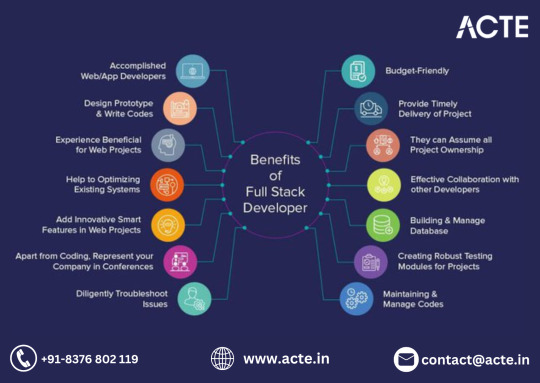
Agile Prototyping and Iteration: Full stack developers possess a knack for rapid prototyping and iteration, leveraging their comprehensive understanding of both front-end and back-end technologies. This proficiency enables them to swiftly prototype and iterate on features, accelerating development cycles and fostering innovation.By gathering feedback iteratively and swiftly incorporating user input and stakeholder feedback, full stack developers expedite the development process. This agile approach allows them to identify and address issues promptly, resulting in faster development cycles and heightened product quality.
Holistic Problem-Solving Proficiency: Full stack developers boast holistic problem-solving skills, enabling them to tackle challenges across the user interface and server layers. With an in-depth comprehension of both front-end and back-end technologies, full stack developers approach problems from diverse angles, exploring a plethora of solutions and technologies to pinpoint the most effective remedy.This comprehensive problem-solving approach fosters creativity, innovation, and critical thinking, as full stack developers explore various methodologies and techniques to resolve intricate problems. By harnessing their diverse skill set and experience, full stack developers surmount obstacles and deliver innovative solutions that cater to user needs and business imperatives.
Continuous Learning and Professional Growth: Full stack development is an ever-evolving domain that encourages continuous learning and professional growth. With new technologies, frameworks, and best practices perpetually emerging, full stack developers have ample opportunities to augment their skill set and remain abreast of industry trends.Continuous learning is inherent to the full stack developer role, necessitating a commitment to staying abreast of the latest advancements in both front-end and back-end technologies. By investing in continuous learning and professional development, full stack developers remain competitive in the job market and position themselves for sustained success in their careers.
Conclusion: In summary, embracing full stack development bestows a myriad of advantages and opportunities, ranging from versatility and end-to-end project ownership to enhanced employability and continuous learning. By mastering both front-end and back-end technologies, full stack developers are primed to excel in diverse roles and environments, driving innovation and success in the ever-evolving sphere of software development. Whether you're an established developer or an aspiring professional, embracing full stack development opens doors to a world of possibilities and professional fulfillment.
#full stack course#full stack developer#full stack software developer#full stack training#full stack web development
4 notes
·
View notes
Text
Leading the Way in IT- ChatGPT's Transformative Impact
In the dynamic world of Information Technology, a transformative force is reshaping the field: ChatGPT. This advanced AI, built on the sophisticated GPT-3.5 framework, is not just a revolutionary tool but a catalyst for unprecedented innovation, efficiency, and enhanced human-AI collaboration.

The ChatGPT Edge With its deep understanding of context, nuanced responses, and adaptive learning, ChatGPT stands as a groundbreaking advancement in natural language processing. It's a boon for IT professionals, enabling them to tackle complex problems, improve team communication, and offer solutions tailored to the unique challenges of the IT realm. Revolutionizing DevOps Communication ChatGPT marks a significant leap in DevOps, facilitating smoother communication and collaboration. It excels in interpreting natural language, allowing real-time issue resolution, task automation, and fostering a culture of continuous improvement. DevOps teams can leverage ChatGPT for enhanced decision-making and adaptability in the ever-changing landscape of software development. Enhancing Product Development Cycles In product development, ChatGPT's contribution is invaluable. It streamlines the lifecycle by grasping complex requirements and generating structured specifications. Teams can use ChatGPT to refine ideas rapidly, leading to more effective development processes and innovative solutions that align with user expectations. Advancing Mobile and Web Application Development For web and mobile app developers, ChatGPT accelerates the coding process. Its ability to understand context and generate code quickens development cycles. Integrating ChatGPT into workflows helps tackle coding challenges, troubleshoot, and enhance code quality, resulting in a more agile and responsive development process. The Future of IT with ChatGPT Looking ahead, ChatGPT's role in IT is poised to expand significantly. This fusion of conversational AI and technical acumen will revolutionize collaboration and innovation across DevOps, product development, and app development. ChatGPT is set to be a key driver in creating an adaptable, efficient, and collaborative IT ecosystem.
ChatGPT is guiding the IT industry towards an era where efficiency and collaboration take center stage. As organizations adopt this transformative technology, the sectors of DevOps, product development, and app development are on the cusp of a major evolution. Embrace ChatGPT as it leads the charge in IT innovation, where efficiency meets creativity in the digital world.
#devops#product engineering#information technology#software development#product development#upperthrusttechnologies#chatgpt#ai tools#ai technology#openai
2 notes
·
View notes
Text
Web Application Development Life Cycle: A 2024 Brief Guide for Dedicated Developers!
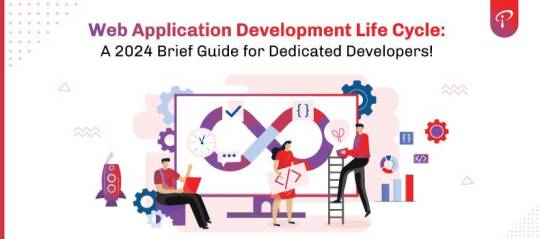
In the current iterative landscape, having a website just isn’t enough. You need a powerful web application, or a high-performance website to truly stand out. Nowadays, customers expect a rich & seamless online experience, and that’s exactly what web application development offers.
No matter the industry, from IT to retail, a well-designed lifecycle of web application is the key to attract new audience & retain the present ones.
While coding is a crucial part, web application development cycle is a multi-armed process. With countless factors to consider, a structured approach is essential to ensure a smooth and successful project.
Don’t settle for just a website — get driven results with a strategic web application development life cycle!
This proven methodology breaks down the process into 7 key phases, ensuring a smooth journey from concept to a website that stands out. We’ll delve into each step of this web application development checklist, giving you a clear roadmap to success.
Let’s bring your vision online.
What is Web Application Development?
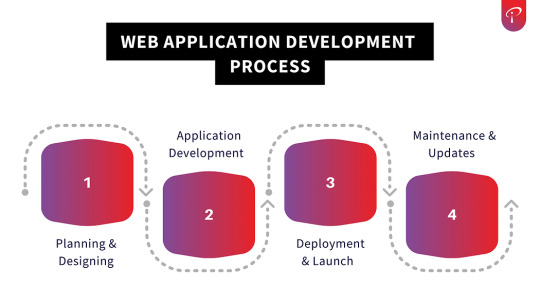
As mentioned before, while coding is a crucial step, the web application development process is a more decorated journey, with the following stages:
1. Planning and Designing the Web Application
Here, clients define the website’s intent, target audience, wireframe- among other technical aspects to craft user-friendly interfaces.
2. Web Application Development
Here, web application developers bring the designed code to life while integrating databases and ensuring smoother-than-butter user interactions.
3. Deployment & Launch
This step ensures that the well-designed web application is made accessible to the world using servers to host them on.
4. Maintenance & Updates
This step involves keeping the website safe and secure, up-to-date and functioning optimally.
This web development process can be further broken down into three areas of development, all depending on where the code runs: server-side, client-side, and full-stack development to make the web app a success.
Behind the layers of web application development
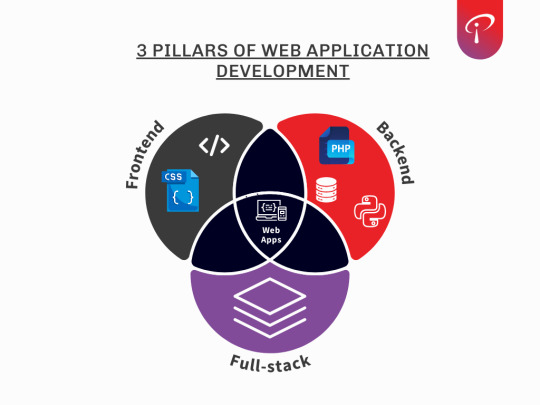
In the industry of web application development services, there exist three behind-the-scenes layers that everyone must know:
1. Server-side, or backend
The server side is responsible for everything happening behind the scenes of the development. It handles the databases, servers, and all the logical components required to power a web application’s functionality- basically the central nervous system of any web application.
Here is what happens:
– Database Management through interactions between backend and databases like MySQL to store and retrieve critical data to support the application’s functionalities.
– Languages such as PHP, Python, or Node.js are used to write server-side scripts to handle user requests, perform complex calculations, or even manage server resources efficiently.
– The backend is also responsible in case any API is being built to allow other applications to interact with the base data and functionality.
2. Client-side, or frontend
This inside layer pays attention to the user experience, or UX, and the visual presentation of any web application. It encompasses what users see and interact with directly.
Frontend developers usually use:
– HTML markup to build the core structure and content of the web page.
– CSS stylesheets to define visual appearance of the page, like layout, colors, and onts.
– JavaScript to add interactivity and dynamicity to the frontend’s functionality. This makes the web apps more engaging and responsive.
3. Full-stack development
This is considered the master of both worlds- the backend and the frontend. This includes the expertise to manage every aspect of the web application development process, from designing the databases to UI/UX design.
Web application developers must possess in-depth knowledge about these layers to build robust and efficient web applications; each layer plays a vital part in a well-coordinated development team to ensure seamless collaboration and communication.
Let’s delve deeper into the different methodologies one can choose from in web application development process:
Web Application Development Methodologies
When you hire the best web application development company, you’ll mostly collaborate closely with their team. This involves discussing project requirements, overseeing progress, and analyzing results.
An important first step is to select the correct web application development methodology. Since various methodologies exist, one can choose which is best suited for their project priorities, such as:
– Goals & resources
– Scale and time taken
– Team composition
– Project management tools in use
Any web application developer must align his/her decisions in tandem with needs and resources available to get optimal results. In this section, we will explore the widely used methodologies in web application development.
Waterfall Methodology
This methodology is a linear, sequential approach to web application development utilized by traditional developers. It’s one of the oldest and most structured methods in the industry, due to its structured and plan-driven nature.
Key Features of Waterfall Methodology
1. Sequential phases, allowing enough attention to each one before moving to the next.
2. Comprehensive documentation to gather detailed records at every quantifiable stage.
3. Rigid structure leading to limited flexibility for changes
4. Detailed upfront and predictive planning.
The Waterfall Methodology Step-by-Step
1. Requirement gathering
2. System design
3. Implementation
4. Testing
5. Deployment
6. Maintenance
Pros & Cons of Waterfall Methodology
Advantages
Clear development structure
Easy to manage and understand
Ideal for clients with fixed requirements
Disadvantages
Inflexible to any changes
Delayed testing phase
Higher chances of delayed project deployment
When to use the Waterfall Methodology?
This is best suited for when:
– Projects have well-defined requirements
– Systems require high reliability
– Scenarios demand extensive documentation
We know that the waterfall methodology has a lot of limitations in a fast-paced development process. However, it remains a valuable methodology for different projects.
A web application developer must understand the strengths and weaknesses associated with the waterfall methodology to make the process a success.
Agile Methodology
Agile methodology is a wildly chosen iterative development approach to build web applications. This is well-suited for web app processes requiring dynamic needs and tight deadlines.
Key Features of Agile
1. Iterative development with work done in continual sprints.
2. Adaptive approach to planning to allow for more flexibility within the web application development process.
3. Continuous improvement through regular reviews and updates.
4. Improved external collaboration through frequent interactions with necessary shareholders.
Core principles of Agile Development
The following ways are in which the agile methodology of web application development functions:
1. Prioritizing working software over comprehensive documentation
2. Embrace changing requirements, even late in development
3. Deliver functional software frequently
4. Foster daily cooperation between developers and business stakeholders
Pros and Cons of Agile Methodology
Advantages
Faster time-to-market
Increased shareholder satisfaction
Bettered product quality through continuous testing and refinement
Improved team productivity
Disadvantages
Requires active efforts across organization
Less suitable for projects with fixed scopes of development
Can be challenging for high projects without proper planning
When to use the Agile Methodology?
Agile is ideal for when:
– Projects have evolving requirements
– Web applications need rapid deployment and frequent updates
– Teams seek to respond quickly to market changes or user feedback
We’ve come to understand that agile methodology presents itself as a flexible, efficient approach to web application development. Its focus on adaptability and continuous improvement makes it an excellent choice for projects in dynamic environments where requirements may change rapidly.
Scrum Methodology
Scrum, a popular Agile framework, emphasizes collaboration, flexibility, and rapid delivery in software development projects. It’s particularly effective for web app development companies seeking a structured yet adaptive approach.
Key principles of scrum
1. Iterative Development: Work is completed in short, time-boxed cycles called Sprints
2. Self-Organizing Teams: Empowers team members to manage their own work
3. Continuous Improvement: Regular reflection and adaptation of processes
4. Transparency: Clear visibility of project progress to all stakeholders
Pros & Cons of Scrum
Advantages
Faster delivery of working software
Increased stakeholder satisfaction through regular feedback
Enhanced team collaboration and communication
Flexibility to adapt to changing requirements
Improved quality through continuous testing and refinement
Disadvantages
Requires commitment to Scrum principles from all team members
May be challenging for teams new to Agile methodologies
Not ideal for projects with fixed scope and minimal changes
When to use scrum?
Scrum is ideal for:
– Web projects with evolving requirements
– Teams capable of self-organization
– Projects requiring frequent client feedback and adjustments
– Smaller to medium-sized development teams (typically 3–9 members)
While methodologies like Waterfall, Agile, and Scrum provide frameworks for managing web app development processes, they all operate within the broader context of the web development life cycle.
This cycle encompasses the entire journey of a web application from conception to deployment and maintenance.
Where methodologies focus on project management and team workflows, the life cycle provides a comprehensive view of the stages every web app goes through, regardless of the chosen methodology.
Let’s now explore the web development life cycle, which typically consists of several key phases.
Each phase builds upon the previous one, creating a roadmap for turning an initial concept into a fully functional web application.
Lifecycle of Web Application : 7 Critical Stages from Start to Finish
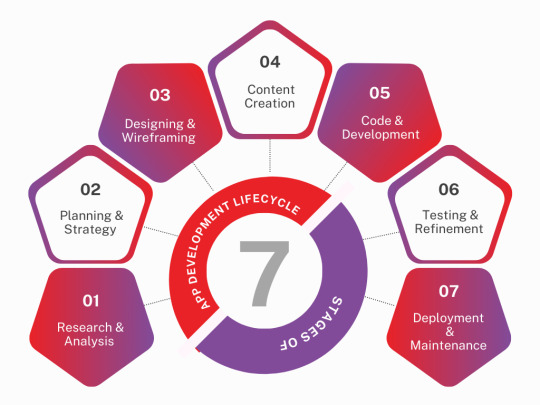
1. Research & Analysis
Research and analysis form the cornerstone of effective web application development. This crucial first step ensures that your design and development efforts align with project goals and client needs.
Many overlook the crucial initial phase of web development: research and information gathering. This oversight can lead to misaligned projects and inefficient solutions.
To set any web application development project on the right course from the outset, it’s essential to collect comprehensive information about both the project and the client.
Why Information Gathering Matters?
– Aligns Development with Goals: Ensures the final product meets client objectives
– Prevents Costly Mistakes: Reduces the need for major revisions later in development
– Enhances Efficiency: Provides developers with clear direction, streamlining the process
Here, we delve deep to understand the exact individuals you’re aiming to reach with your website. This involves creating a detailed user persona by considering:
Demographics: Uncovering key characteristics like age, gender, location, income, and education level. This paints a broad picture of who the target audience is.
Preferences and Needs: What are the users hoping to achieve with the website? What problems are they trying to solve? Identifying their desires and pain points is crucial for crafting a website that resonates with them.
Behaviors and Motivations: Understanding how the audience behaves online and what motivates them to interact with websites is essential. Analyze browsing habits, online behavior patterns, and what triggers users to take action.
By gaining a comprehensive understanding of the target audience, web application developers can ensure the website speaks directly to them, offering a user experience that is not only functional but also deeply relevant to their needs.
2. Planning & Strategy
This phase is a crucial step in web development where all aspects of the website — including design, technology, content, and marketing — are strategized based on the insights gathered during the research phase.
This stage involves forming a dedicated team with clearly defined roles and tasks, making informed decisions about the website’s structure and features, and creating a comprehensive development plan.
The technology stack, comprising programming languages, web frameworks, and software, is carefully chosen to support the project’s needs.
Finally, decisions regarding the website’s branding are made before transitioning to the Design phase. This thorough planning ensures a solid foundation for the entire development process, aligning all elements with the project’s goals and user requirements.
3. Designing & Wireframing
The design stage is where your website’s visual identity takes shape. Here, the abstract concepts are transformed into tangible visual elements, placing UI-UX designers at the forefront of the web application development process.
This stage usually involves:
Layout Creation: Developing rough sketches or graphical representations to visualize the website’s structure and feel.
Wireframe Evolution: Transforming initial wireframes into interactive elements such as buttons, tabs, menus, and dashboards.
Visual Identity Development: Establishing color themes, typography, and graphics to create a cohesive base layout.
User-Centric Design: Incorporating insights from target audience research to ensure the design meets user preferences and needs.
Balancing Aesthetics and Functionality: Including engaging visual elements while maintaining alignment with the website’s branding and purpose.
Interactive Prototyping: Creating clickable prototypes to demonstrate user flow and gather early feedback.
The goal is to craft an engaging, visually appealing interface that not only attracts users but also effectively communicates the website’s core message and functionality.
This phase sets the visual foundation for the entire user experience, bridging the gap between concept and implementation.
4. Content Creation
The adage “content is king” rings true in the world of web development.
No matter how stunning your website’s design is, if you can’t effectively communicate with your audience, you’ll miss the mark.
The content creation stage is where this gap is bridged, establishing a clear channel of communication through the user interface.
This stage focuses on developing informative and engaging content that educates your visitors about your company and its offerings. The content should be easy to understand, visually appealing, and optimized for search engines.
This includes writing clear and concise text, crafting compelling headlines, and utilizing effective formatting and editing techniques.
Content creation is an ongoing process, requiring updates and revisions throughout the life cycle of the web application.
By carefully crafting desired message, one can communicate the website’s purpose and value proposition to the target audience. Focusing on how your products or services solve user problems thereby drives conversions.
While design attracts, it’s the content that ultimately convinces and converts.
By investing in high-quality, strategic content creation — whether through skilled writers or AI-assisted tools — you create a powerful conduit for meaningful interaction with your audience, turning visitors into loyal customers.
5. Code and Development
The development phase is where the magic happens — the website’s design transforms into a fully functional online experience. This stage typically involves the most time as it requires meticulous coding on both the front-end (client-side) and back-end (server-side) of the web application.
This stage is typically the most time-intensive and can be divided into two main areas:
A. Front-end development The front-end development phase takes your web design, essentially a blueprint, and breathes life into it, transforming it into an interactive experience.
Here’s how this magic happens:
Web application designers collaborate with front-end developers to translate the design elements into functional components. They utilize web frameworks and development tools to achieve this.
The cornerstones of front-end development are HTML, CSS, and JavaScript. HTML provides the website’s structure, acting like a skeleton. CSS defines the visual styles, akin to the muscles and skin, influencing layout, colors, and fonts. JavaScript adds interactivity and dynamic behavior, making the website feel alive and responsive to user actions.
To streamline this process and ensure efficiency, popular frameworks like Bootstrap or Foundation come into play. These frameworks offer pre-built components and styling options, essentially pre-made building blocks that can be used to create websites using HTML and CSS faster.
B. Back-end development The front-end may be the user interface, but the back end is the beating heart of any web application. Back-end developers act as the architects, building the server-side infrastructure that powers website functionality.
First, they construct the server-side application, choosing and configuring a database management system (DBMS) like MySQL to store website data.
They then write server-side scripts using languages like Python or Node.js to handle user requests, perform complex calculations, and manage server resources efficiently.
In some cases, they may even build APIs (Application Programming Interfaces) that allow other applications to interact with the website’s data.
By employing techniques like caching and database indexing, they ensure fast loading times and a smooth user experience.
In recent times, Search Engine Optimization (SEO) has become increasingly important, and back-end developers integrate SEO best practices into the website’s architecture to improve search engine ranking.
By mastering this diverse skillset, back-end web application developers ensure the website functions flawlessly, safeguards user data, and delivers an optimized user experience.
6. Testing & Refinement
Once the web application development is complete, it undergoes a rigorous testing phase to guarantee a flawless user experience.
The Quality Assurance (QA) team meticulously executes a variety of testing methods to identify and eliminate any potential bugs or glitches. They employ various testing methodologies, including unit testing, stress testing, integration testing.
This ensures all functionalities, usability aspects, compatibility across devices and platforms, and overall performance meet the expected standards. sting, and load testing. Additionally, the QA team collaborates with developers to optimize the website for deployment. This may involve testing plugins and fine-tuning SEO for better online discovery.
By integrating testing throughout development, you can identify and fix issues early on, saving time and resources, and ultimately delivering a high-quality website that exceeds user expectations.
7. Deployment and Maintenance
Following QA sign-off, the application undergoes deployment to production servers using a method like File Transfer Protocol (FTP), enabling public access.
Valuable user feedback becomes the roadmap for ongoing improvement. Leverage the web application development life cycle (WDLC) to continuously iterate and enhance the website based on user needs.
Regular maintenance and updates are also paramount.
They ensure smooth functionality, address security vulnerabilities, and keep your website content fresh and engaging for new users. This focus on continuous improvement helps your website thrive in the ever-evolving digital landscape.
The web development life cycle (WDLC) is a powerful framework, guiding the creation of exceptional websites from conception to launch and beyond.
Every phase, from design and content generation to coding, testing, and maintenance, plays a critical role in the final product. While coding is undeniably important, it’s just one piece of the puzzle.
This collaborative approach, coupled with a commitment to continuous improvement throughout the lifecycle, is the key to crafting a website that thrives in the ever-evolving digital world.
Remember, website development is a journey, not a destination.
By embracing this mindset and refining the approach with each iteration, one can create a web application that exceeds expectations and achieves your digital goals.
Our Trusted Web Application Development Services
At iProgrammer, we don’t just build web applications, we craft exceptional user experiences. Our web development services are like a well-rehearsed play — every component, from the front-end design to the back-end functionality, undergoes rigorous testing to ensure flawless performance.
Partner with our 350+ experts today, and transform your web app idea into a digital masterpiece that not only functions flawlessly but resonates deeply with your target audience!
#web application development services#web application development#web application development lifecycle#web app development#web application development process#iprogrammer#app development
0 notes
Text
Streamlining Web Application Testing with Selenium: An In-Depth Exploration
The landscape of web development demands meticulous attention to the seamless functioning of applications across diverse platforms and browsers. Enter Selenium, an open-source framework that has emerged as a cornerstone for automated web application testing. In this blog, we delve into the pivotal aspects and advantages of Selenium tests, shedding light on its significance within the software development lifecycle.

Decoding Selenium Tests: Automated Precision in Testing
Selenium tests stand as automated scripts meticulously crafted using the Selenium framework, a widely embraced open-source tool designed explicitly for web application testing. These scripts represent the pinnacle of automation, meticulously validating web application functionality by replicating user interactions, providing insights akin to real-world user experiences.
Versatility Across Development Ecosystems
Selenium's prowess is evident in its support for multiple programming languages, including Java, Python, C#, Ruby, and more. This adaptability ensures Selenium seamlessly integrates into different development environments, allowing teams to leverage their preferred programming language for automated testing.
Critical Aspects of Selenium Tests
Let's delve into key facets that underscore the indispensable nature of Selenium tests in the testing toolkit:
Cross-Browser Compatibility: Selenium's capability to support a variety of browsers ensures consistent performance across platforms, a crucial factor in delivering a uniform user experience across the digital landscape.
Platform Independence: Selenium's platform-agnostic nature allows it to operate seamlessly on Windows, Linux, and macOS. This flexibility proves advantageous for development teams working in diverse computing environments.
Multi-Language Support: The compatibility of Selenium with multiple programming languages empowers development teams to choose their preferred language. This adaptability fosters collaboration and efficiency within the testing and development processes.
Open Source and Community Support: Selenium's open-source lineage has birthed a robust and supportive community. This collaborative environment ensures continuous development, regular updates, and a plethora of resources for users.
Extensibility and Integration: Selenium effortlessly integrates with various testing frameworks and CI/CD tools, enhancing its capabilities. This seamless integration streamlines the testing process, facilitating efficient automation within continuous integration pipelines.

Dynamic Web Application Support: Selenium excels in the testing of dynamic web applications that leverage technologies like AJAX and JavaScript. Its ability to interact with and validate dynamic elements ensures a comprehensive evaluation of modern web applications.
Parallel Test Execution: Selenium Grid facilitates parallel test execution on multiple machines and browsers simultaneously. This feature significantly reduces overall test execution time, proving invaluable for testing large suites of test cases efficiently.
Headless Browser Testing: Selenium's support for headless browser testing is particularly beneficial in scenarios where a graphical user interface is unnecessary. This feature streamlines testing in background processes or on servers, contributing to faster and more efficient testing.
Conclusion: Elevating Software Quality through Selenium Precision
In conclusion, Selenium tests emerge as a linchpin in the software development lifecycle, automating the testing of web applications and contributing to enhanced efficiency and accelerated feedback cycles. Professionals aspiring to deepen their understanding and proficiency in utilizing Selenium for effective web application testing can embark on dedicated training programs. Embrace the transformative power of Selenium and unlock a realm of possibilities in the domain of web automation.
2 notes
·
View notes
Text
web design company in patna
web design company in patna

In Patna, the capital city of Bihar, India, several website design companies cater to the growing demand for online presence and digital solutions. Choosing the right website design company in Patna involves considering various factors to ensure that your web presence reflects your brand effectively. Here’s an overview of what to look for when selecting a website design company in Patna, encompassed within a 500-word limit:
Local Presence and Reputation: Seek a company with a physical presence in Patna and a positive reputation in the local market. Check their experience working with businesses in the region and their familiarity with the local audience and market trends.
Portfolio and Expertise: Review their portfolio to assess the quality and diversity of their previous work. Look for designs that resonate with your vision and demonstrate creativity, functionality, and responsiveness across various industries.
Client Testimonials and Reviews: Check for client testimonials, reviews, and case studies to understand the experiences of their previous clients. Testimonials can provide insights into the company's reliability, communication, and the ability to deliver on promises.
Technical Expertise and Services: Ensure the company possesses technical expertise in website design, development, and other services you might require, such as SEO, e-commerce solutions, mobile responsiveness, and content management systems (CMS) like WordPress, Joomla, or Drupal.
Customization and Client-Centric Approach: Look for a company that values client input and offers customized solutions tailored to your business needs. A client-centric approach ensures that the website reflects your brand identity and goals effectively.
Communication and Support: Effective communication is crucial for a successful project. Assess their communication channels, responsiveness to queries, and the willingness to provide regular updates throughout the project lifecycle. Also, inquire about post-launch support and maintenance services.
Cost and Value Proposition: Consider the cost of services in relation to the value provided. While cost is important, prioritize value and quality over a low price. Ensure transparency in pricing and clarity on what services are included in the quoted price.
Timeline and Project Management: Discuss the estimated timeline for project completion and their approach to project management. A reliable company should have a structured project plan and a realistic timeline to meet deadlines effectively.
Local Market Understanding: Look for a company that understands the local market dynamics, cultural nuances, and preferences of the audience in Patna. This understanding can help in crafting a website that resonates well with the target audience.
#website designing#online marketing#digital marketing#ott development#website design#ott develop#ott develops#ott#webdevelopment
2 notes
·
View notes
Text
Amazon DCV 2024.0 Supports Ubuntu 24.04 LTS With Security

NICE DCV is a different entity now. Along with improvements and bug fixes, NICE DCV is now known as Amazon DCV with the 2024.0 release.
The DCV protocol that powers Amazon Web Services(AWS) managed services like Amazon AppStream 2.0 and Amazon WorkSpaces is now regularly referred to by its new moniker.
What’s new with version 2024.0?
A number of improvements and updates are included in Amazon DCV 2024.0 for better usability, security, and performance. The most recent Ubuntu 24.04 LTS is now supported by the 2024.0 release, which also offers extended long-term support to ease system maintenance and the most recent security patches. Wayland support is incorporated into the DCV client on Ubuntu 24.04, which improves application isolation and graphical rendering efficiency. Furthermore, DCV 2024.0 now activates the QUIC UDP protocol by default, providing clients with optimal streaming performance. Additionally, when a remote user connects, the update adds the option to wipe the Linux host screen, blocking local access and interaction with the distant session.
What is Amazon DCV?
Customers may securely provide remote desktops and application streaming from any cloud or data center to any device, over a variety of network conditions, with Amazon DCV, a high-performance remote display protocol. Customers can run graphic-intensive programs remotely on EC2 instances and stream their user interface to less complex client PCs, doing away with the requirement for pricey dedicated workstations, thanks to Amazon DCV and Amazon EC2. Customers use Amazon DCV for their remote visualization needs across a wide spectrum of HPC workloads. Moreover, well-known services like Amazon Appstream 2.0, AWS Nimble Studio, and AWS RoboMaker use the Amazon DCV streaming protocol.
Advantages
Elevated Efficiency
You don’t have to pick between responsiveness and visual quality when using Amazon DCV. With no loss of image accuracy, it can respond to your apps almost instantly thanks to the bandwidth-adaptive streaming protocol.
Reduced Costs
Customers may run graphics-intensive apps remotely and avoid spending a lot of money on dedicated workstations or moving big volumes of data from the cloud to client PCs thanks to a very responsive streaming experience. It also allows several sessions to share a single GPU on Linux servers, which further reduces server infrastructure expenses for clients.
Adaptable Implementations
Service providers have access to a reliable and adaptable protocol for streaming apps that supports both on-premises and cloud usage thanks to browser-based access and cross-OS interoperability.
Entire Security
To protect customer data privacy, it sends pixels rather than geometry. To further guarantee the security of client data, it uses TLS protocol to secure end-user inputs as well as pixels.
Features
In addition to native clients for Windows, Linux, and MacOS and an HTML5 client for web browser access, it supports remote environments running both Windows and Linux. Multiple displays, 4K resolution, USB devices, multi-channel audio, smart cards, stylus/touch capabilities, and file redirection are all supported by native clients.
The lifecycle of it session may be easily created and managed programmatically across a fleet of servers with the help of DCV Session Manager. Developers can create personalized Amazon DCV web browser client applications with the help of the Amazon DCV web client SDK.
How to Install DCV on Amazon EC2?
Implement:
Sign up for an AWS account and activate it.
Open the AWS Management Console and log in.
Either download and install the relevant Amazon DCV server on your EC2 instance, or choose the proper Amazon DCV AMI from the Amazon Web Services Marketplace, then create an AMI using your application stack.
After confirming that traffic on port 8443 is permitted by your security group’s inbound rules, deploy EC2 instances with the Amazon DCV server installed.
Link:
On your device, download and install the relevant Amazon DCV native client.
Use the web client or native Amazon DCV client to connect to your distant computer at https://:8443.
Stream:
Use AmazonDCV to stream your graphics apps across several devices.
Use cases
Visualization of 3D Graphics
HPC workloads are becoming more complicated and consuming enormous volumes of data in a variety of industrial verticals, including Oil & Gas, Life Sciences, and Design & Engineering. The streaming protocol offered by Amazon DCV makes it unnecessary to send output files to client devices and offers a seamless, bandwidth-efficient remote streaming experience for HPC 3D graphics.
Application Access via a Browser
The Web Client for Amazon DCV is compatible with all HTML5 browsers and offers a mobile device-portable streaming experience. By removing the need to manage native clients without sacrificing streaming speed, the Web Client significantly lessens the operational pressure on IT departments. With the Amazon DCV Web Client SDK, you can create your own DCV Web Client.
Personalized Remote Apps
The simplicity with which it offers streaming protocol integration might be advantageous for custom remote applications and managed services. With native clients that support up to 4 monitors at 4K resolution each, Amazon DCV uses end-to-end AES-256 encryption to safeguard both pixels and end-user inputs.
Amazon DCV Pricing
Amazon Entire Cloud:
Using Amazon DCV on AWS does not incur any additional fees. Clients only have to pay for the EC2 resources they really utilize.
On-site and third-party cloud computing
Please get in touch with DCV distributors or resellers in your area here for more information about licensing and pricing for Amazon DCV.
Read more on Govindhtech.com
#AmazonDCV#Ubuntu24.04LTS#Ubuntu#DCV#AmazonWebServices#AmazonAppStream#EC2instances#AmazonEC2#News#TechNews#TechnologyNews#Technologytrends#technology#govindhtech
2 notes
·
View notes
Text
website design company in patna
website design company in patna

In Patna, the capital city of Bihar, India, several website design companies cater to the growing demand for online presence and digital solutions. Choosing the right website design company in Patna involves considering various factors to ensure that your web presence reflects your brand effectively. Here’s an overview of what to look for when selecting a website design company in Patna, encompassed within a 500-word limit:
Local Presence and Reputation: Seek a company with a physical presence in Patna and a positive reputation in the local market. Check their experience working with businesses in the region and their familiarity with the local audience and market trends.
Portfolio and Expertise: Review their portfolio to assess the quality and diversity of their previous work. Look for designs that resonate with your vision and demonstrate creativity, functionality, and responsiveness across various industries.
Client Testimonials and Reviews: Check for client testimonials, reviews, and case studies to understand the experiences of their previous clients. Testimonials can provide insights into the company's reliability, communication, and the ability to deliver on promises.
Technical Expertise and Services: Ensure the company possesses technical expertise in website design, development, and other services you might require, such as SEO, e-commerce solutions, mobile responsiveness, and content management systems (CMS) like WordPress, Joomla, or Drupal.
Customization and Client-Centric Approach: Look for a company that values client input and offers customized solutions tailored to your business needs. A client-centric approach ensures that the website reflects your brand identity and goals effectively.
Communication and Support: Effective communication is crucial for a successful project. Assess their communication channels, responsiveness to queries, and the willingness to provide regular updates throughout the project lifecycle. Also, inquire about post-launch support and maintenance services.
Cost and Value Proposition: Consider the cost of services in relation to the value provided. While cost is important, prioritize value and quality over a low price. Ensure transparency in pricing and clarity on what services are included in the quoted price.
Timeline and Project Management: Discuss the estimated timeline for project completion and their approach to project management. A reliable company should have a structured project plan and a realistic timeline to meet deadlines effectively.
Local Market Understanding: Look for a company that understands the local market dynamics, cultural nuances, and preferences of the audience in Patna. This understanding can help in crafting a website that resonates well with the target audience.
2 notes
·
View notes